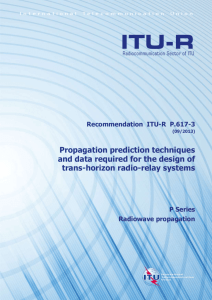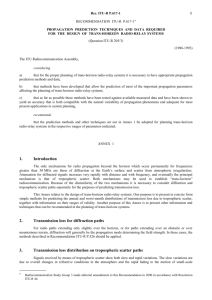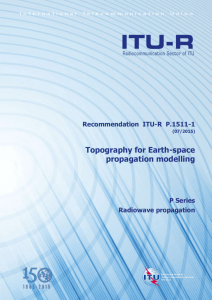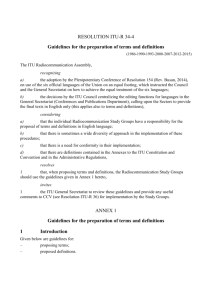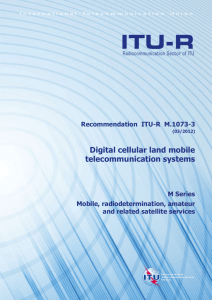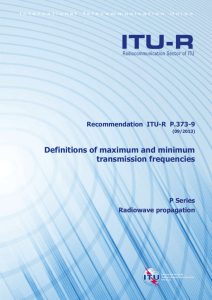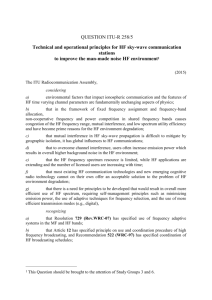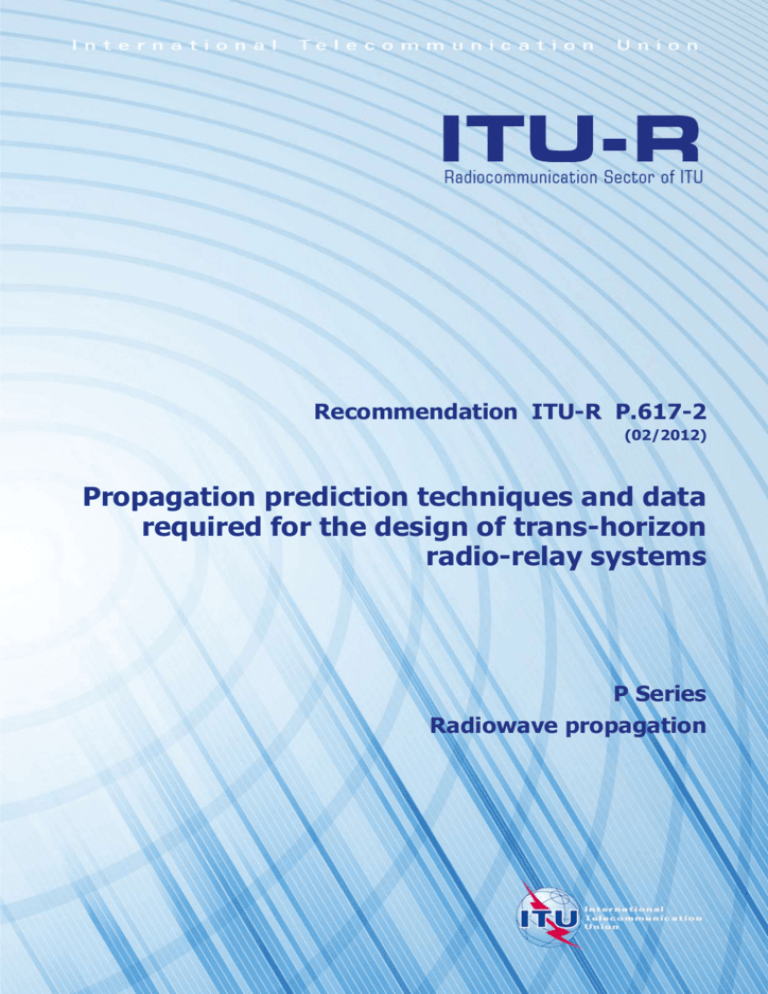
Recommendation ITU-R P.617-2
(02/2012)
Propagation prediction techniques and data
required for the design of trans-horizon
radio-relay systems
P Series
Radiowave propagation
ii
Rec. ITU-R P.617-2
Foreword
The role of the Radiocommunication Sector is to ensure the rational, equitable, efficient and economical use of the
radio-frequency spectrum by all radiocommunication services, including satellite services, and carry out studies without
limit of frequency range on the basis of which Recommendations are adopted.
The regulatory and policy functions of the Radiocommunication Sector are performed by World and Regional
Radiocommunication Conferences and Radiocommunication Assemblies supported by Study Groups.
Policy on Intellectual Property Right (IPR)
ITU-R policy on IPR is described in the Common Patent Policy for ITU-T/ITU-R/ISO/IEC referenced in Annex 1 of
Resolution ITU-R 1. Forms to be used for the submission of patent statements and licensing declarations by patent
holders are available from http://www.itu.int/ITU-R/go/patents/en where the Guidelines for Implementation of the
Common Patent Policy for ITU-T/ITU-R/ISO/IEC and the ITU-R patent information database can also be found.
Series of ITU-R Recommendations
(Also available online at http://www.itu.int/publ/R-REC/en)
Series
BO
BR
BS
BT
F
M
P
RA
RS
S
SA
SF
SM
SNG
TF
V
Title
Satellite delivery
Recording for production, archival and play-out; film for television
Broadcasting service (sound)
Broadcasting service (television)
Fixed service
Mobile, radiodetermination, amateur and related satellite services
Radiowave propagation
Radio astronomy
Remote sensing systems
Fixed-satellite service
Space applications and meteorology
Frequency sharing and coordination between fixed-satellite and fixed service systems
Spectrum management
Satellite news gathering
Time signals and frequency standards emissions
Vocabulary and related subjects
Note: This ITU-R Recommendation was approved in English under the procedure detailed in Resolution ITU-R 1.
Electronic Publication
Geneva, 2012
ITU 2012
All rights reserved. No part of this publication may be reproduced, by any means whatsoever, without written permission of ITU.
Rec. ITU-R P.617-2
1
RECOMMENDATION ITU-R P.617-2*
Propagation prediction techniques and data required
for the design of trans-horizon radio-relay systems
(Question ITU-R 205/3)
(1986-1992-2012)
The ITU Radiocommunication Assembly,
considering
a)
that for the proper planning of trans-horizon radio-relay systems it is necessary to have
appropriate propagation prediction methods and data;
b)
that methods have been developed that allow the prediction of most of the important
propagation parameters affecting the planning of trans-horizon radio-relay systems;
c)
that as far as possible these methods have been tested against available measured data and
have been shown to yield an accuracy that is both compatible with the natural variability of
propagation phenomena and adequate for most present applications in system planning,
recommends
that the prediction methods and other techniques set out in Annex 1 be adopted for planning
trans-horizon radio-relay systems in the respective ranges of parameters indicated.
Annex 1
1
Introduction
The only mechanisms for radio propagation beyond the horizon which occur permanently for
frequencies greater than 30 MHz are those of diffraction at the Earth’s surface and scatter from
atmospheric irregularities. Attenuation for diffracted signals increases very rapidly with distance
and with frequency, and eventually the principal mechanism is that of tropospheric scatter. Both
mechanisms may be used to establish “trans-horizon” radiocommunication. Because of the
dissimilarity of the two mechanisms it is necessary to consider diffraction and tropospheric scatter
paths separately for the purposes of predicting transmission loss.
This Annex relates to the design of trans-horizon radio-relay systems. One purpose is to present in
concise form simple methods for predicting the annual and worst-month distributions of
transmission loss due to tropospheric scatter, together with information on their ranges of validity.
Another purpose of this Annex is to present other information and techniques that can be
recommended in the planning of trans-horizon systems.
*
Radiocommunication Study Group 3 made editorial amendments to this Recommendation in 2000 in
accordance with Resolution ITU-R 44.
2
2
Rec. ITU-R P.617-2
Transmission loss for diffraction paths
For radio paths extending only slightly over the horizon, or for paths extending over an obstacle or
over mountainous terrain, diffraction will generally be the propagation mode determining the field
strength. In these cases, the methods described in Recommendation ITU-R P.526 should be applied.
3
Transmission loss distribution on tropospheric scatter paths
Signals received by means of tropospheric scatter show both slow and rapid variations. The slow
variations are due to overall changes in refractive conditions in the atmosphere and the rapid fading
to the motion of small-scale irregularities. The slow variations are well described by distributions of
the hourly-median transmission loss which are approximately log-normal with standard deviations
between about 4 and 8 dB, depending on climate. The rapid variations over periods up to about 5
min are approximately Rayleigh distributed.
In determining the performance of trans-horizon links for geometries in which the tropospheric
scatter mechanism is predominant, it is normal to estimate the distribution of hourly-median
transmission loss for non-exceedance percentages of the time above 50%. A simple semi-analytical
technique for predicting the distribution of average annual transmission loss in this range is given in
§ 3.1. A graphical technique for translating these annual time percentages to those for the average
worst month is given in § 3.2. Finally, guidance is given in § 3.3 on estimation of the transmission
loss distribution for small percentages of time for use in obtaining receiver dynamic ranges
required. Appendix 1 includes additional supporting information on seasonal and diurnal variations
in transmission loss, on frequency of rapid fading on tropospheric scatter paths and on transmission
bandwidth.
3.1
Average annual median transmission loss distribution for time percentages greater
than 50%
The following step-by-step procedure is recommended for estimating the average annual median
transmission loss L(q) not exceeded for percentages of the time q greater than 50%. The procedure
requires the link parameters of great-circle path length d (km), frequency f (MHz), transmitting
antenna gain Gt (dB), receiving antenna gain Gr (dB), horizon angle t (mrad) at the transmitter, and
horizon angle r (mrad) at the receiver:
Step 1: Determine the appropriate climate for the common volume of the link in question using the
climate map of Fig. 1. This map is available electronically from the ITU-R SG 3 website at the link
“Software for ionospheric and tropospheric propagation and radio noise”.
Rec. ITU-R P.617-2
3
FIGURE 1
Latitude
Climate zone classification
Longitude
1
2
3
4
5
6
If the troposcatter common volume lies over the sea, the climates at both the transmitter and
receiver locations are determined. If both terminals have a climate zone corresponding to a land
point, the climate zone of the path is given by the smaller value of the transmitter and receiver
climate zones. If only one terminal has a climate zone corresponding to a land point, then that
climate zone defines the climate zone of the path. If neither terminal has a climate zone
corresponding to a land point, the path is assigned a “sea path” climate zone.
Step 2: Obtain the meteorological and atmospheric structure parameters M and , respectively, and
the equation to be used for calculating Y(90) from Table 1 for the climate in question.
TABLE 1
Values of meteorological and atmospheric structure parameters
Climate
1
2
3
4
5
6
Sea
M (dB)
39.60
29.73
19.30
38.50
29.73
33.20
26.00
(km–1)
30.33
20.27
10.32
30.27
20.27
30.27
20.27
Y(90) Equation
9
7
10
11
7
7
8
Step 3: Calculate the scatter angle (angular distance) from
e t rmmmmmmmrad
(1)
where t and r are the transmitter and receiver horizon angles, respectively, and
e d 103 / kammmmmmmrad
(2)
4
Rec. ITU-R P.617-2
with:
d:
path length (km)
a
6 370 km radius of the Earth
k:
effective earth radius factor for median refractivity conditions (k 4/3 should
be used unless a more accurate value is known)
Step 4: Estimate the transmission loss dependence LN on the height of the common volume from:
LN 20 log(5 H ) 4.34 hmmmmmmdB
(3)
H 10–3 d / 4mmmmmmkm
(4)
h 10–6 2k a / 8mmmmmkm
(5)
where:
and is the atmospheric structure parameter obtained in Step 2.
Step 5: Estimate the conversion factor Y(q) for non-exceedance percentages q other than 50% from:
Y(q) C(q) Y(90)mmmmmmdB
(6)
Here Y(90) is the conversion factor for q 90% given by the appropriate equation (7-11) as
indicated in Table 1 for the climate in question:
Y90 2.2 8.1 2.3 104 min 1000 f ,4000 exp 0.137h
(7)
Y90 9.5 3 exp 0.137h
(8)
Y90 8.2
ds < 100
(9a)
100 ≤ ds < 1000
(9b)
Y90 3.4
otherwise
(9c)
Y90 10.845
ds < 100
(10a)
100 ≤ ds < 550
(10b)
Y90 4.0
otherwise
(10c)
Y90 11.5
ds < 100
(11a)
100 ≤ ds < 465
(11b)
otherwise
(11c)
Y90 1.006 108 d s3 2.569 105 d s2 0.224d s 10.2
Y90 4.5 107 d s3 4.45 104 d s2 0.122d s 2.645
Y90 8.519 108 d s3 7.444 105 d s2 4.18 104 d s 12.1
Y90 8.4
Rec. ITU-R P.617-2
5
The coefficient C(q) for the non-exceedance percentage of time q in question can be obtained from
Table 2.
FIGURE 2
Y(90) for climates 1, 3 and 4
Y(90) (dB)
0
–5
Climate 1
4
–10
3
–15
100
300
500
700
900
ds (km)
TABLE 2
Values of C(q) of interest
q
50
90
99
99.9
99.99
C(q)
50
91
91.82
92.41
92.90
Step 6: Estimate the aperture-to-medium coupling loss Lc from:
Lc = 0.07 exp [0.055(Gt Gr)]mmmmmmdB
(12)
where Gt and Gr are the antenna gains.
Step 7: Estimate the average annual transmission loss not exceeded for q% of the time from:
L(q) M 30 log f 10 log d 30 log LN Lc – Gt – Gr – Y(q)mmmmmmdB
(13)
NOTE 1 – Equation (13) is an empirical formula based on data for the frequency range between 200 MHz
and 4 GHz. It can be extended to 5 GHz with little error for most applications.
3.2
Average worst-month median transmission loss distribution for time percentages
greater than 50%
For reasons of consistency with the average annual transmission loss distribution, this distribution is
best determined from the average annual distribution by means of a conversion factor. The
procedure is as follows:
Step 1: Obtain the average annual distribution for the non-exceedance percentages (50, 90, 99,
99.9) and climate(s) of interest using the technique in § 3.1.
Step 2: Obtain the basic transmission loss difference between the average annual distribution and
the average worst-month distribution from the curves of Fig. 3. Since curves are not available for
climate 2, the curves for climate 3 should be used for climate 2 instead.
6
Rec. ITU-R P.617-2
Step 3: Add the difference in Step 2 to the corresponding average annual values obtained in Step 1
to obtain the average worst-month transmission losses for the non-exceedance percentages (50, 90,
99, 99.9).
Step 4: Average worst-month transmission losses not exceeded for 99.99% of the time can be
estimated from the values above by logarithmic extrapolation (i.e. extrapolating from a plot on
normal probability paper).
3.3
Average annual median transmission loss distribution for time percentages less than
50%
For percentages of time between about 20% (as low as 1% in some dry climates over land) and
50%, the average annual transmission loss distribution can be considered symmetrical and the
transmission loss values estimated from the corresponding values above the median, i.e.
L(20%) L(50%) – [ L(80%) – L(50%)]
(14)
However, for dynamic range calculations requiring estimates of the distribution for lower time
percentages, pure tropospheric scatter cannot be assumed. The transmission loss values not
exceeded for very small percentages of time will be determined by the duct propagation
mechanism. These values are best estimated by the technique given in Recommendation
ITU-R P.452.
4
Diversity reception
The deep fading occurring with tropospheric scatter propagation severely reduces the performance
of systems using this propagation mode. The effect of the fading can be reduced by diversity
reception, using two or more signals which fade more or less independently owing to differences in
scatter path or frequency. Thus, the use of space, angle, or frequency diversity is known to decrease
the percentages of time for which large transmission losses are exceeded. Angle diversity, however,
can have the same effect as vertical space diversity and be more economical.
Rec. ITU-R P.617-2
7
FIGURE 3
Curves giving the difference between worst-month basic transmission
loss and annual basic transmission loss
6
50%
90%
4
2
99%
99.9%
0
Equivalent distance (km)
a) Equatorial climate (climate 1)
8
6
50%
90%
99%
4
99.9%
2
Basic transmission loss difference (dB)
0
Equivalent distance (km)
b) Humid tropical climate (climate 3)
12
50%
10
90%
8
6
99%
99.9%
4
2
0
Equivalent distance (km)
c) Desert climate (climate 4)
10
50%
8
6
90%
99%
99.9%
4
2
0
100
200
500
Equivalent distance (km)
d) Temperate climate (climates 7a and 7b)
1 000
8
4.1
Rec. ITU-R P.617-2
Space diversity
Diversity spacing in the horizontal or vertical can be used depending on whatever is most
convenient for the location in question. Adequate diversity spacings h and v in either the
horizontal or vertical, respectively, for frequencies greater than 1 000 MHz are given by the
empirical relations
1 / 2
1/ 2
v 0.36 D 2 4 I v2
h 0.36 D 2 4 I h2
m
(15)
m
(16)
where D is the antenna diameter in metres and Ih 20 m and Iv 15 m are empirical scale lengths in
the horizontal and vertical directions, respectively.
4.2
Frequency diversity
For installations where it is desired to employ frequency diversity, an adequate frequency separation
f (MHz) is given for frequencies greater than about 1 000 MHz by the relation:
f 1.44 f / d D2 I v2
1 / 2
MHz
(17)
where:
f:
D:
frequency (MHz)
antenna diameter (m)
:
scatter angle (mrad) obtained from equation (1)
Iv
4.3
15 m the scale length noted above.
Angle diversity
Vertical angle diversity can also be used in which two or more antenna feeds spaced in the vertical
direction are employed with a common reflector. This creates different vertically-spaced common
volumes similar to the situation for vertical space diversity. The angular spacing r required to
have approximately the same effect as the vertical spacing v (m) in equation (16) on an
approximately symmetrical path is:
r arc tan (v / 500d)
(18)
where d is the path length (km).
5
Effect of the siting of stations
The siting of transmission links requires some care. The antenna beams must not be obstructed by
nearby objects and the antennas should be directed slightly above the horizon. The precise optimum
elevation is a function of the path and atmospheric conditions, but it lies within about 0.2 to 0.6
beamwidths above the horizon.
Measurements made by moving the beam of a 53 dB gain antenna away from the great-circle
horizon direction of two 2 GHz transmitters, each 300 km distant, demonstrated an apparent rate-ofdecrease of power received of 9 dB per degree. This occurred with increases of scattering angle
over the first three degrees, in both azimuth and elevation, for each path, and for a wide range of
time percentages.
Rec. ITU-R P.617-2
9
Appendix 1
Additional supporting material
1
Seasonal and diurnal variations in transmission loss
In temperate climates, transmission loss varies annually and diurnally. Monthly median losses tend
to be higher in winter than in summer. The range is 10 to 15 dB on 150-250 km overland paths but
diminishes as the distance increases. Measurements made in the European parts of the Russian
Federation on a 920 km path at 800 MHz show a difference of only 2 dB between summer and
winter medians. Diurnal variations are most pronounced in summer, with a range of 5 to 10 dB on
100-200 km overland paths. The greatest transmission loss occurs in the afternoon, and the least in
early morning. Oversea paths are more likely to be affected by super-refraction and elevated layers
than land paths, and so give greater variation. This may also apply to low, flat coastal regions in
maritime zones.
In dry, hot desert climates attenuation reaches a maximum in the summer. The annual variations of
the monthly medians for medium-distance paths exceed 20 dB, while the diurnal variations are very
large.
In equatorial climates, the annual and diurnal variations are generally small.
In monsoon climates where measurements have been carried out (Senegal, Barbados), the
maximum values of Ns occur during the wet season, but the minimum attenuation is between the
wet and dry seasons.
2
Frequency of rapid fading on tropospheric scatter paths
The rapid fading has a frequency of a few fades per minute at lower frequencies and a few hertz at
UHF. The superposition of a number of variable incoherent components would give a signal whose
amplitude was Rayleigh distributed and this is found to be nearly true when the distribution is
analysed over periods of up to 5 min. If other types of signal form a significant part of that received,
there is a modification of this distribution. Sudden, deep and rapid fading has been noted when a
frontal disturbance passes over a link. Reflections from aircraft can give pronounced rapid fading.
The frequency of the rapid fading has been studied in terms of the time autocorrelation function,
which provides a “mean fading frequency” for short periods of time for which the signal is
stationary. The median value of the mean fading frequency was found to increase nearly
proportionally to path length and carrier frequency, and to decrease slightly with increasing antenna
diameter.
Measurements have also shown that the rapidity of fading is greatest when the hourly median
transmission loss is greater than the long-term median. In general it was found that the fading rate
decreased with decreasing transmission loss below the long-term median, the lowest fading rates
occurring for events in which duct propagation was predominant.
It is the most rapid fading for hourly-median transmission loss values larger than the long-term
median that is most important, and the few measurements available (at 2 GHz) give median fading
rates between about 20 and 30 fades/min.
10
3
Rec. ITU-R P.617-2
Transmissible bandwidth
The various discontinuities which give rise to scatter propagation, create propagation paths which
may vary in number and in transmission time. Accordingly, the transmission coefficients for two
adjacent frequencies are not entirely correlated, which leads to a distortion of the transmitted signal.
The transmissible bandwidth is the bandwidth within which the distortion caused by this
phenomenon is acceptable for the transmitted signal. This bandwidth therefore depends both on the
nature of the transmitted signal (multiplex telephony, television picture, etc.) and on the acceptable
distortion for this signal. Studies carried out in France show that:
–
increasing the antenna gain widens the transmissible bandwidth to the extent where the gain
degradation increases also (i.e. for gains exceeding approximately 30 dB);
–
all other things being equal, the transmissible bandwidth depends on the atmospheric
structure and hence on the climatic zone in question;
–
the transmissible bandwidth becomes narrower as the distance increases, but this is
governed by a law which is not the same for all climates;
–
the transmissible bandwidth becomes narrower when there are positive angles of departure,
and wider when these angles are negative.


